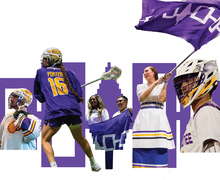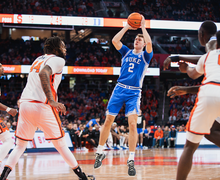Downstate divide evident in primary
Jacob Greenfeld | Staff Photographer
New York state Gov. Andrew Cuomo (D) is challenged by Cynthia Nixon in the Gubernatorial election.
The exact downstate border of upstate New York is undefined. If you ask five residents, you may get five different answers. But, no matter where you believe upstate New York truly begins, one thing is perfectly clear — the region isn’t discussed enough when it comes to state politics.
Two weeks ago, New York state Gov. Andrew Cuomo (D) and challenger Cynthia Nixon, of the Working Families Party, faced off for their first, and last, debate before the Democratic primary is held Thursday. A good indication of what state issues politicians and commentators care about was on display.
In questions asked at the debate, only two New York cities were mentioned: New York City, where about 43 percent of the state population lives, and Albany, where the state capitol and governor’s mansion are located.

Laura Angle | Digital Design editor
Other areas may have received a passing note, but not nearly enough to indicate to voters that upstate issues were important.
When voters from across the state go to the polls Thursday to vote for the Democratic nominee for governor, a significant portion of those voters will be choosing without knowing what either candidate has to say about issues important to them. The debate between the two candidates was the only chance voters had to see them face-to-face.
It’s important to acknowledge that there are reasons why gubernatorial candidates choose to focus their attention on New York City, especially when those candidates are seeking a nomination from the Democratic Party. If you look at the 2016 election results in New York state, most upstate areas voted Republican. Even in November, during the 2018 midterm elections, FiveThirtyEight forecasts that a majority of upstate congressional districts are at least “likely Republican” seats.
The physical separation between upstate New York and New York City represents an ideological divide. Kristi Anderson, a professor emeritus of political science at the Maxwell School of Citizenship and Public Affairs, said that understanding allows candidates to strategize around the divide.
“They can just deal with upstate or just deal with downstate. You don’t have people talking productively, and competing, to figure out policies for the entire state,” Anderson said.
If a political line between the two was ever drawn, it would exist right at the New York City border.
Looking toward the future, there’s certainly a potential for politicians running for state office to make upstate or even central New York a key part of their campaigns — candidates just have to make the effort to show upstate voters that their message applies to everybody, not just those downstate.
On Thursday, hundreds of thousands of New Yorkers will cast their vote in the primary. Many of those voters will do so even though they may have little idea of where the candidates stand on major upstate issues. A democratic society works best when voters feel invested in elections, and the New York gubernatorial election has shown that the candidates are invested in only a select number of voters.
Nick Turner is a senior political science and policy studies major. His column appears weekly. He can be reached at nturner@syr.edu.
Published on September 12, 2018 at 7:28 pm






